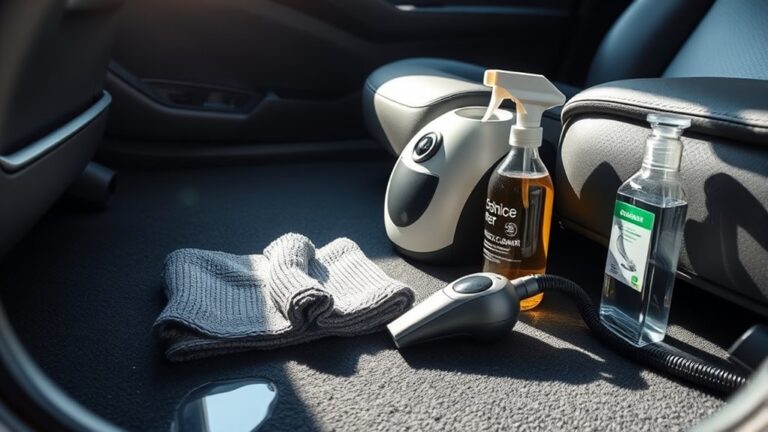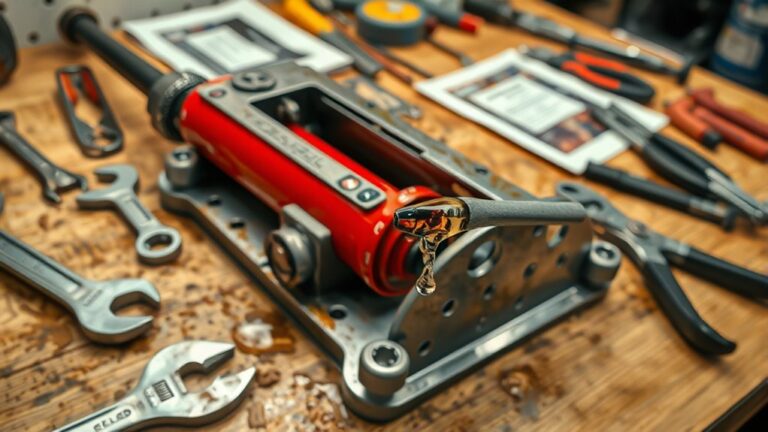When your cat scratches the floor, it’s following natural instincts to maintain claw health, mark territory with scent glands, and stretch muscles for exercise. This behavior also helps relieve stress and express emotions, giving your cat a sense of security and control. Understanding these key reasons can help you support your cat’s needs while protecting your home. You’ll find practical ways to balance your cat’s well-being with preserving your floors.
The Natural Instinct Behind Scratching

Although it might seem puzzling at first, your cat’s behavior of scratching the Boden is deeply rooted in its natural instincts. Scratching habits are an important aspect of feline behavior, serving multiple biological and psychological purposes. When your cat scratches surfaces, it helps maintain claw health by removing old outer layers. Additionally, this activity provides a necessary outlet for physical exercise and stress relief, supporting their overall well-being. Understanding these instincts can help you appreciate your cat’s need to express its natural urges freely. Rather than viewing scratching as destructive, recognizing it as a crucial behavior allows you to create environments that respect your cat’s innate drives while promoting harmonious coexistence. Embracing this knowledge empowers you to support your feline friend’s freedom and health responsibly.
How Cats Use Scratching to Mark Territory
Beyond maintaining claw health and relieving stress, scratching also plays a significant role in how cats communicate and establish boundaries. When your cat scratches the floor, they’re engaging in territorial marking, a natural behavior that signals ownership of their space. This action isn’t random; specialized glands in their paws release pheromones during scratching, providing scent signaling that communicates their presence to other animals. By understanding this, you can appreciate that your cat’s scratching is an important way they assert freedom and security in their environment. Recognizing these behaviors helps you respect their need to express autonomy while managing your shared space. Supporting this instinct in appropriate ways allows your cat to thrive comfortably without compromising your living area.
The Role of Claw Maintenance in Scratching

You might not realize it, but your cat scratches the floor to help shed the outer layers of its claws, keeping them sharp and healthy. This natural process conditions their nails and prevents overgrowth, which can cause discomfort. Understanding this behavior helps you appreciate how important claw maintenance is for your cat’s well-being.
Claw Shedding Process
Since cats rely heavily on their claws for balance, hunting, and defense, maintaining sharp and healthy claws is essential. You should understand that the claw shedding process plays a significant role in claw health by allowing your cat to remove old, worn outer layers. This natural renewal occurs regularly, with shedding frequency varying between individual cats based on age, activity level, and environment. When your cat scratches the floor, it helps loosen and shed these outer claw sheaths, promoting growth of fresh, sharp claws underneath. By facilitating this process, your cat preserves its freedom to move confidently and defend itself effectively. Recognizing this, you can appreciate that scratching isn’t just a habit—it’s an important biological mechanism supporting your cat’s overall well-being and autonomy.
Sharpness Preservation Techniques
Three key techniques help cats preserve the sharpness of their claws, and scratching plays a central role in each. You’ll notice that sharpness maintenance involves natural claw care behaviors essential for their freedom and mobility. Scratching removes worn outer layers, exposing sharper, fresher claws underneath. It also conditions the claws to prevent brittleness.
| Technik | Zweck | Ergebnis |
|---|---|---|
| Shedding old claw layers | Removes dull surfaces | Sharp, functional claws |
| Scratching on rough surfaces | Maintains claw edge integrity | Prevents splitting |
| Controlled claw retraction | Avoids overgrowth | Balanced sharpness |
Understanding these techniques helps you appreciate the natural claw care cats perform to stay sharp and agile.
Natural Claw Conditioning
Building on how cats preserve claw sharpness through natural behaviors, it’s important to recognize that scratching also plays a significant role in conditioning the claws themselves. This essential feline behavior helps maintain claw health by removing old, worn outer layers, revealing fresh, strong tissue beneath. When your cat scratches the floor, they’re not only marking territory but actively engaging in a self-care routine critical to their mobility and hunting instincts. By understanding this, you appreciate the freedom cats express through their innate need to condition their claws. Supporting this behavior with appropriate outlets prevents damage to your home and promotes your cat’s physical well-being. Prioritizing claw health through natural scratching encourages a harmonious coexistence that respects both your cat’s instincts and your living space.
Scratching as a Form of Exercise and Stretching

When your cat scratches the floor, it’s more than just a habit—it’s a way to stretch their muscles and stay active. This natural behavior helps them maintain flexibility and promotes overall physical health. Understanding this can help you appreciate how scratching supports your cat’s well-being.
Muscle Stretching Benefits
Although scratching might seem like a simple behavior, it plays an essential role in helping cats stretch and exercise their muscles effectively. When your cat scratches the floor, they’re engaging key muscle groups, enhancing muscle flexibility through natural stretching techniques. This action not only lengthens muscles but also strengthens tendons and ligaments, supporting overall mobility. Understanding this, you can appreciate how scratching offers cats a form of self-maintained physical wellness, allowing them to maintain freedom of movement without restraint. By enabling your cat to scratch safely, you support their instinctual need to keep muscles limber and healthy. This behavior is a vital part of their physical routine, promoting comfort and preventing stiffness, which ultimately contributes to their long-term well-being.
Physical Activity Boost
Scratching engages your cat in a natural form of exercise that combines stretching with physical activity. When your cat scratches the floor, it participates in playful antics that promote muscle tone and flexibility. This behavior allows for an energetic release, essential for maintaining physical health and mental well-being. You’ll notice your cat extends its limbs fully, which helps to stretch muscles and tendons, preventing stiffness and injury. This activity also stimulates circulation and coordination, supporting overall vigor. Understanding this, you can appreciate how scratching serves as both a physical and psychological outlet, satisfying your cat’s innate need for movement and exploration. Encouraging this behavior, within appropriate boundaries, supports your cat’s freedom to express natural instincts healthily and energetically.
Stress Relief and Emotional Expression Through Scratching
Understanding your cat’s need to scratch offers insight into their emotional well-being. Scratching isn’t just physical; it’s an essential outlet for stress relief and emotional expression. When your cat scratches the floor, they’re releasing tension and communicating feelings you might not see otherwise. Recognizing this behavior helps you support their mental freedom and comfort.
- Scratching alleviates anxiety by allowing muscle release and focus.
- It serves as a non-verbal way to express emotions like frustration or excitement.
- The act triggers endorphin release, promoting calmness.
- Scratching marks their territory, providing a sense of security and control.
The Impact of Environment on Scratching Behavior
Because your cat’s environment plays an essential role in their behavior, changes in surroundings can greatly influence how and when they scratch. When you provide appropriate environmental enrichment, you offer your cat outlets to express natural behaviors like scratching in healthier ways. The surface texture of the floor or objects around them can either encourage or deter scratching. Rough or uneven surfaces often attract more scratching, while smooth ones may not. If your cat’s environment lacks stimulation, they might scratch more out of boredom or frustration. By thoughtfully designing their space with varied textures and interactive elements, you support their instinctual needs and reduce unwanted scratching. Understanding this connection helps you respect your cat’s freedom to express themselves while managing their impact on your living space.
How to Protect Your Floors From Cat Scratching
Protecting your floors from cat scratching involves a combination of prevention, deterrence, and providing suitable alternatives. You want to maintain your freedom to enjoy your space without damage or frustration. Start by applying protective coatings to vulnerable areas; these create a barrier that’s hard for claws to penetrate. Next, place scratching mats strategically to redirect your cat’s instinct away from floors. You can also:
- Use furniture protectors to shield edges and corners
- Employ gentle deterrents like double-sided tape or safe sprays
- Keep your cat’s nails trimmed regularly
- Create a comfortable environment that reduces anxiety-driven scratching
These steps help you preserve your floors while respecting your cat’s natural behavior, maintaining harmony in your home without restricting your or your cat’s freedom.
Providing Appropriate Alternatives for Scratching
While prevention and deterrence play important roles in minimizing floor damage, offering your cat suitable alternatives for scratching can greatly reduce unwanted behavior. You should provide scratching posts made from materials like sisal or cardboard, as these textures satisfy your cat’s natural urge to scratch. Position these posts near areas where your cat already scratches or rests, encouraging use without restriction. Additionally, introducing alternative surfaces such as carpeted pads or wooden panels can diversify options and keep your cat engaged. Remember, cats seek freedom to express their instincts, so ensuring accessible and appealing alternatives respects their needs while protecting your floors. Regularly rotate or refresh these alternatives to maintain interest, fostering a balance between your cat’s freedom and your home’s preservation.




